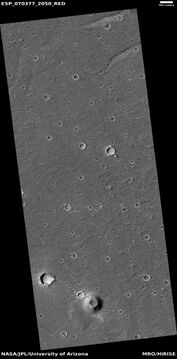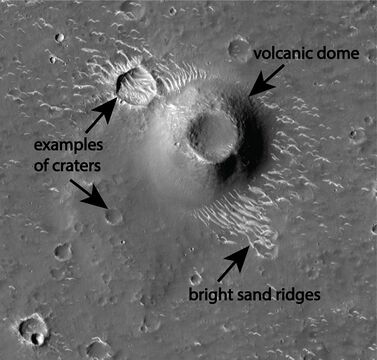Difference between revisions of "Zhurong"
(added new info) |
|||
| Line 1: | Line 1: | ||
| − | Zhurong is a six-wheeled rover built by | + | Zhurong is a six-wheeled rover built by China. It landed on Mars in the area called Utopia Planitia on May 14, 2021. Zhurong is about the size of NASA's twin Mars rovers Spirit and Opportunity. It has six scientific instruments, including two panoramic cameras, a ground-penetrating radar and a magnetic field detector. Like America's Curiosity and Perseverance Martian rovers, Zhurong has a laser to zap rocks and thereby study their compositions.<ref>https://www.space.com/china-mars-rover-landing-success-tianwen-1-zhurong</ref> |
<gallery class="center" widths="380px" heights="360px"> | <gallery class="center" widths="380px" heights="360px"> | ||
| Line 11: | Line 11: | ||
</gallery> | </gallery> | ||
| + | Research published in May, 2022 described chemical evidence for water discovered by the Zhurong Rover. Hydrated sulfate/silica materials were identified on the Amazonian-age terrain at the landing site. These hydrated minerals were found in bright-toned rocks. Authors of the research interpreted these minerals to be from a "duricrust." The duricrust was formed either by groundwater rising or subsurface ice melting. This duricrust was on the surface, then was buried, and then was uncovered by erosion. | ||
== References == | == References == | ||
Revision as of 07:17, 13 May 2022
Zhurong is a six-wheeled rover built by China. It landed on Mars in the area called Utopia Planitia on May 14, 2021. Zhurong is about the size of NASA's twin Mars rovers Spirit and Opportunity. It has six scientific instruments, including two panoramic cameras, a ground-penetrating radar and a magnetic field detector. Like America's Curiosity and Perseverance Martian rovers, Zhurong has a laser to zap rocks and thereby study their compositions.[1]
Research published in May, 2022 described chemical evidence for water discovered by the Zhurong Rover. Hydrated sulfate/silica materials were identified on the Amazonian-age terrain at the landing site. These hydrated minerals were found in bright-toned rocks. Authors of the research interpreted these minerals to be from a "duricrust." The duricrust was formed either by groundwater rising or subsurface ice melting. This duricrust was on the surface, then was buried, and then was uncovered by erosion.
References









